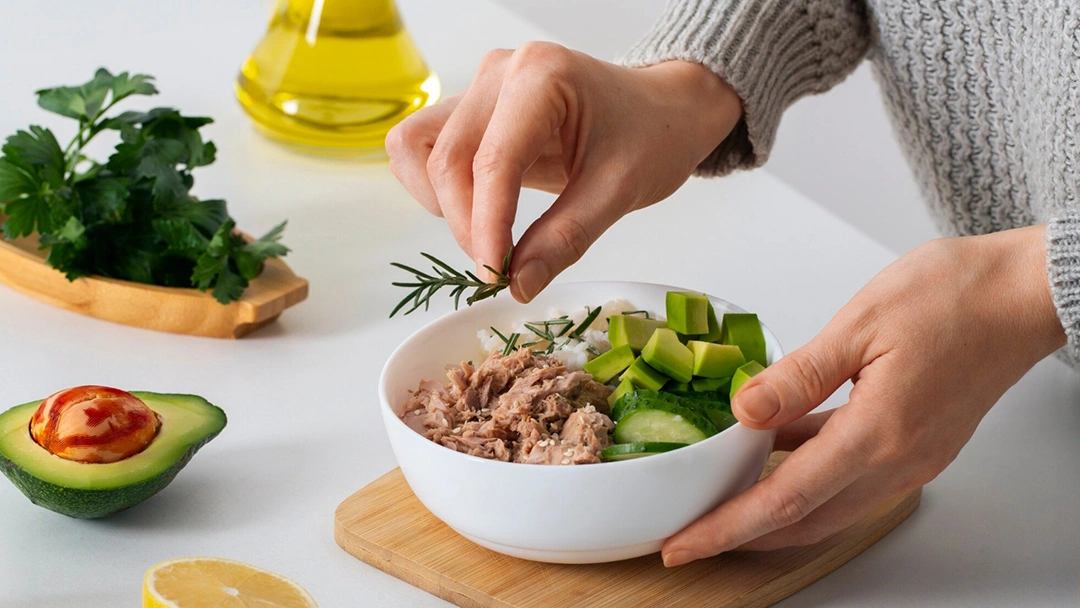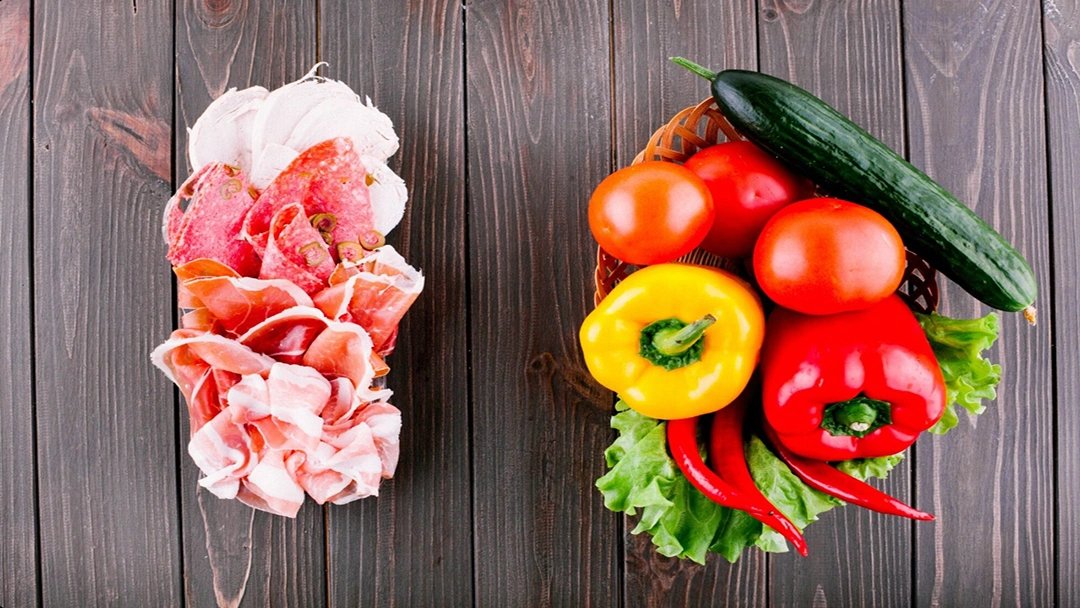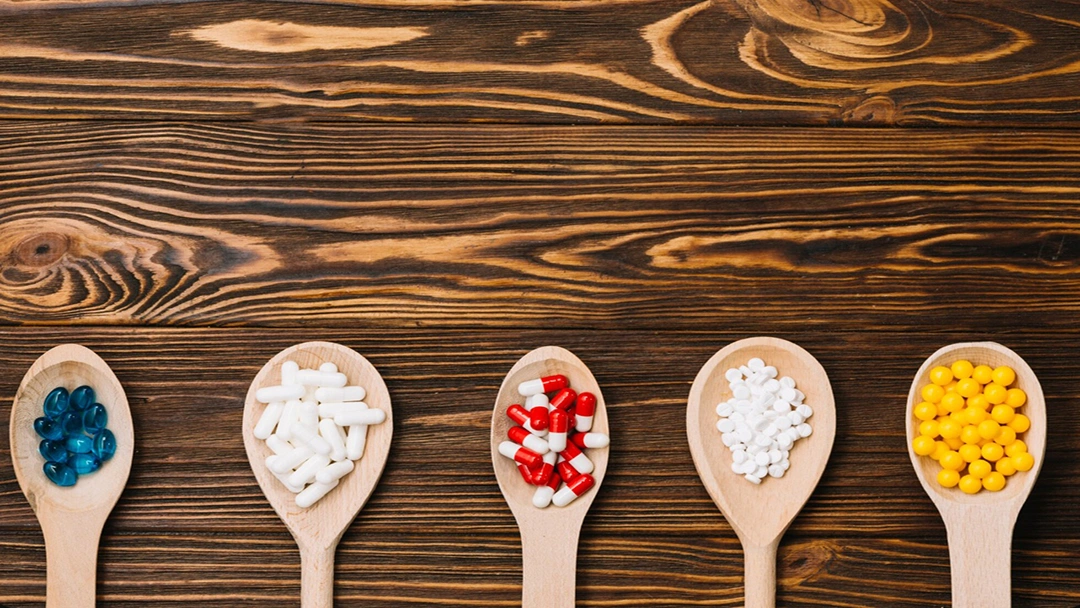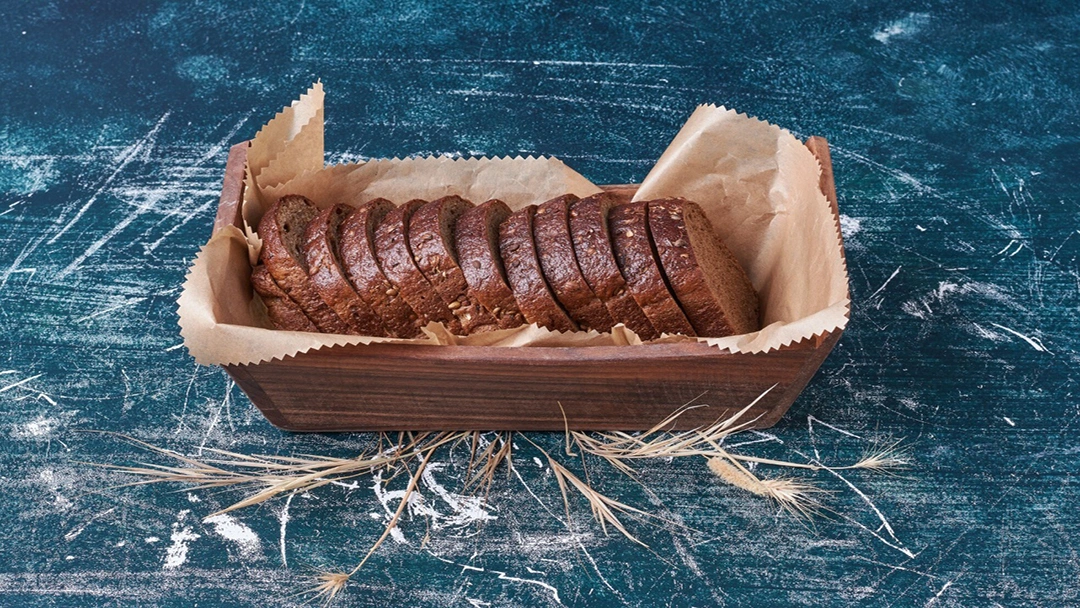The Low-Carb Diet Food List
The key to starting a Low-Carb Diet is to focus on whole, unprocessed foods that are naturally low in carbohydrates and rich in proteins and healthy fats. Here’s the Low-Carb Diet food list:
- Meat and Poultry: Beef, pork, chicken, turkey, lamb, etc.
- Fish and Seafood: Salmon, cod, tuna, etc.
- Eggs
- Oils: Ghee, olive oil, avocado oil, etc.
- Non-Starchy Vegetables: leafy greens like spinach, kale, arugula, zucchini, avocado, mushrooms, eggplants, etc.
- Dairy: Cheese, heavy cream, yogurt, cream cheese, butter
- Nuts and S: Pecans, almonds, walnuts, chia seeds, flaxseeds, sunflower seeds, etc.
- Fruits: Berries, coconut, olives, etc.
- Beverages: Water, flavored sparkling water, coffee, tea, etc.
- Herbs and Spices: Basil, rosemary, thyme, pepper, turmeric, garlic powder, etc.
- Condiments and Sauces: Mustard, mayonnaise, sugar-free ketchup, soy sauce, hot sauce, etc.
- Sweeteners: Stevia, erythritol, monk fruit, etc.
To get a complete list with examples and nutritional values, check the Low-Carb Diet Food List.
[cta-meal-plan]
The Keto Diet Food List
On the Keto Diet, you need to reduce carbohydrates more than on the Low-Carb Diet so that you can consume the following foods:
- Proteins: Meat, poultry, fatty fish, and eggs
- Healthy Fats and Oils: Avocado oil, MCT oil, olive oil, lard, tallow, etc.
- Low-Carb Vegetables: Leafy greens and cruciferous vegetables:
- Full-Fat and Low-Carb Dairy: Butter, cheese, heavy cream, sour cream, Greek yogurt
- Low-Carb Nuts and Seeds: Macadamia nuts, pecans, Brazil nuts, pumpkin seeds
- Chia seeds, hemp seeds, etc.
- Low-Carb Fruits: Avocado, olives, berries, etc.
- Drinks: Water, black coffee, black and unsweetened herbal teas, bone broth, etc.
- Herbs and Spices: Parsley, pepper, cumin, paprika, salt, etc.
- Condiments and Sauces: Sugar-free mayonnaise, sugar-free ketchup, vinegar, hot sauce, pesto, etc.
- Low-Carb Sweeteners: Xylitol, stevia, erythritol, etc.
To get a complete list with examples and nutritional values, check the Keto Diet Food List.
[cta-gocarnivore-plans]
The Carnivore Diet Food List
The Carnivore Diet reduced the carbohydrate intake to less than 5% and in some cases 0%. To reach the health benefits it offers, you need to supply about 80% of your calories from healthy fat sources and about 20% from protein, as the list below shows.
- Meat and Poultry: Beef, pork, veal, game meats, chicken, turkey, duck, etc.
- Fish and Seafood: Fatty fish, white fish, shellfish, etc.
- Organ Meats
- Eggs
- Animal Fats: Beef tallow, lard, bone marrow, ghee, etc.
- Low-Carb Dairy in Moderation (Optional): Butter, cheese, heavy cream, sour cream, yogurt (unsweetened and unflavored, ideally grass-fed).
- Sour cream: Full-fat, unprocessed.
- Beverages: Water, bone broth, bulletproof coffee, etc.
To get a complete list with examples and nutritional values, check the Carnivore Diet Food List.
Another important point to consider regarding food sources in the Primal Diet is that you’d better choose grass-fed, organic products.
Why Grass-Fed and Organic Products?
Choosing grass-fed and organic products is often recommended due to the higher nutritional value and fewer harmful additives in these products. Here are the key reasons why grass-fed and organic animal products are considered better:
[cta-meetings]
Nutritional Benefits
Grass-fed and organic meats, dairy, and eggs are generally more nutrient-dense than their conventionally raised counterparts.
- Higher Omega-3 Fatty Acids: Grass-fed animals have been shown to produce meat with 2-4 times more omega-3 fatty acids than grain-fed animals. Omega-3s are anti-inflammatory and beneficial for heart and brain health [1].
- More Conjugated Linoleic Acid (CLA): CLA is a fatty acid found in higher concentrations in grass-fed beef, which has been linked to improved metabolism, weight loss, and anti-cancer properties [2].
- Higher Vitamin Content: Grass-fed meat tends to have more vitamins, such as vitamin A and vitamin E, both of which are important for immune function, skin health, and overall well-being [3].
- No Synthetic Pesticides or Herbicides: Organic meat and dairy products come from animals raised without exposure to synthetic pesticides, which can accumulate in animal fat and later be consumed by humans [4] [5].
- Higher Antioxidant Levels: Organic produce and animal products often have higher levels of antioxidants, which help protect the body from oxidative stress and inflammation [6].
Fewer Hormones and Antibiotics
Unlike conventionally raised livestock, which are given growth hormones and antibiotics to promote faster growth that can negatively impact human health, grass-fed and organic products don’t contain harmful hormones.
Also, organic farming practices do not allow the use of routine antibiotics. Overusing antibiotics in conventional farming can lead to antibiotic resistance, a growing concern in human medicine.
[cta-meal-plan]
Better for the Environment
Grass-fed and organic farming methods are more sustainable and environmentally friendly than conventional industrial farming. Grass-fed animals are raised on pasture, which can help in carbon sequestration—capturing carbon dioxide from the atmosphere and storing it in the soil.
Organic farming practices also avoid harmful chemicals and pesticides that can contaminate soil and water supplies. They generally involve more humane and environmentally friendly animal-raising practices, which results in less land and water degradation.
Additionally, organic farms promote biodiversity by avoiding the use of synthetic chemicals, which can harm local ecosystems.
Ethical and Animal Welfare Considerations
Organic and grass-fed farms often follow higher animal welfare standards than conventional factory farming. Grass-fed animals spend their lives grazing in open pastures rather than confined feedlots, which allows them to express more natural behaviors.
Organic and grass-fed certification often ensures that animals are treated more humanely, have better living conditions, and experience lower stress levels.
Lower Risk of Contaminants
Grass-fed and organic products have fewer harmful contaminants than conventionally raised products. They usually come from animals fed non-GMO (genetically modified organism) feed, reducing potential exposure to genetically modified materials.
Grass-fed and organic meats are less likely to contain residues from pesticides, herbicides, and other chemicals used in industrial farming.
[cta-gocarnivore-plans]
Better Taste and Quality
Grass-fed meats often have a deeper, more complex flavor than grain-fed meat, which can taste fattier or less distinctive. The fat content in grass-fed meats is often higher in healthy fats like omega-3s and CLA, giving the meat a cleaner, more satisfying taste.
So, when shopping for the Primal Diet foods, choose organic, grass-fed products. The following shopping list can also help you find the necessary foods easily, especially if you’re buying bulk to save costs.
Primal Diet Shopping List
The following list includes foods suitable for all three levels of the Primal Diet. Focus on whole, nutrient-dense foods, avoiding processed items, grains, and refined sugars.
Protein Sources
Beef and Pork:
- Ribeye steak
- Ground beef (80/20 or higher fat)
- Pork chops
- Bacon (sugar-free)
- Pork belly
- Beef liver, heart, and kidneys
- Beef brisket
- Sausages (check for no added sugars or fillers)
[cta-meetings]
Poultry:
- Chicken thighs, wings, drumsticks (skin-on for more fat)
- Turkey breast or thighs
- Whole chicken
- Duck
- Quail
Fish and Seafood:
- Salmon (wild-caught)
- Mackerel
- Sardines (packed in olive oil)
- Tuna (fresh or canned)
- Shrimp
- Crab
- Scallops
- Lobster
Eggs:
- Chicken eggs
- Duck eggs
- Quail eggs
Healthy Fats and Oils:
- Butter
- Ghee
- Coconut oil
- Olive oil
- Avocado oil
- Beef tallow
- Pork lard
- Duck fat
- Bone marrow
[cta-meal-plan]
Low-Carb Vegetables (for Low-Carb and Keto Levels)
Leafy Greens:
- Spinach
- Kale
- Arugula
- Romaine lettuce
- Swiss chard
- Cruciferous Vegetables:
- Broccoli
- Cauliflower
- Brussels sprouts
- Cabbage
- Bok choy
Other Low-Carb Vegetables:
- Zucchini
- Bell peppers (in moderation)
- Cucumbers
- Asparagus
- Mushrooms
- Avocado
- Green beans
- Eggplant
- Tomatoes (in moderation)
- Onions (use sparingly)
[cta-gocarnivore-plans]
Dairy (Full-Fat and Low in Carbs)
- Cheese: Cheddar, mozzarella, Swiss, gouda, blue cheese, feta
- Heavy cream
- Sour cream (full-fat, no added sugars)
- Cream cheese (full-fat, plain)
- Greek yogurt (plain, unsweetened)
- Butter
Nuts and Seeds (for Low-Carb and Keto Levels)
Low-Carb Nuts:
- Macadamia nuts
- Pecans
- Brazil nuts
- Walnuts
- Almonds (in moderation)
Low-Carb Seeds:
- Chia seeds
- Flaxseeds
- Pumpkin seeds
- Hemp seeds
- Sunflower seeds
[cta-meetings]
Low-Carb Fruits (in Moderation)
- Avocado
- Berries: Raspberries, strawberries, blackberries (in small amounts)
- Coconut
Beverages
- Water
- Bone broth
- Sparkling water (unsweetened)
- Black coffee (or with heavy cream)
- Herbal tea (unsweetened)
- Electrolyte drinks (sugar-free)
Herbs and Spices
Only salt and pepper are used for the Carnivore Diet.
- Salt (sea salt or Himalayan salt)
- Pepper
- Garlic powder
- Paprika
- Cayenne pepper
- Basil
- Oregano
- Rosemary
- Thyme
- Cumin
- Turmeric
[cta-meal-plan]
Condiments and Sauces (for Low-Carb and Keto)
- Mayonnaise (sugar-free, made with olive or avocado oil)
- Mustard (no sugar added)
- Sugar-free ketchup
- Soy sauce (or tamari for gluten-free)
- Hot sauce (check for no added sugar)
- Vinegar (apple cider, balsamic in moderation)
- Pesto (made without added sugar)
Sweeteners (Low-Carb Options)
- Stevia
- Erythritol
- Monk fruit sweetener
- Xylitol
The last point to consider about the Primal Diet food list is to check the labels to ensure you’re buying the right product. Here are the important factors you need to pay attention to.
[cta-gocarnivore-plans]
How to Read Food Labels for the Primal Diet?
Reading food labels is essential when following the Primal Diet, as it helps you avoid hidden carbs, sugars, and unhealthy ingredients that can derail your progress.
Follow the rules below.
Check the Ingredients List First
The ingredients list is one of the most important parts of a food label, especially for the Primal Diet. Look for:
- Whole foods: The fewer ingredients, the better. Prioritize products made from real, unprocessed ingredients like meats, eggs, and vegetables.
- Avoid refined sugars: Common names for added sugars include cane sugar, high fructose corn syrup, honey, agave, maple syrup, and anything ending in "-ose" (e.g., glucose, fructose).
- Skip artificial additives: Avoid ingredients like artificial sweeteners (aspartame, sucralose), preservatives, and chemical additives. Stick to natural flavors and seasonings.
- Look out for grains and starches: Ingredients like wheat, rice, corn, and potatoes should be avoided. Even small amounts can add unnecessary carbohydrates.
Red Flags:
- Added sugars: Avoid any food that lists sugar or sweeteners high up in the ingredients list.
- Vegetable oils: Stay away from highly processed oils like soybean oil, canola oil, and sunflower oil. Choose products made with healthier fats like olive oil, coconut oil, or butter.
[cta-meetings]
Focus on the Serving Size
Always check the serving size at the top of the label. Some food products may seem low in carbs or calories, but they may have multiple servings per package. This can trick you into consuming more than you realize.
Key Tips:
- Adjust the total carbs, fats, and calories based on how much you’re realistically going to eat.
- If the serving size is much smaller than what you would typically consume, calculate the total based on your actual portion.
Look at Total Carbohydrates
- Total Carbs: This number includes all carbs in the product, including sugars and fiber.
- Net Carbs: Net carbs are total carbohydrates minus fiber and sugar alcohols, which are not digested the same way as regular carbohydrates. Focus on net carbs to stay within your carb limits. Example: Total Carbohydrates: 10g, Fiber: 4g, Net Carbs = 6g (10g total carbs - 4g fiber)
Watch for Hidden Sugars
Even if a product claims to be "sugar-free" or "low-carb," it may still contain hidden sugars. These sugars can spike blood sugar and interfere with ketosis.
Here are the common hidden sugars you need to watch for:
[cta-meal-plan]
- Dextrose
- Maltodextrin
- Corn syrup
- Cane sugar
- Sucrose
- Fructose
- Agave nectar
- Honey
Look for products labeled no added sugar or unsweetened to avoid unnecessary sugar intake.
Analyze the Fats
Since the Primal Diet is high in healthy fats, check the types of fats in the product. Choose items rich in saturated fats and monounsaturated fats and avoid trans fats and excessive omega-6 fatty acids found in processed vegetable oils.
Good Fats:
- Saturated fats: Found in butter, coconut oil, and animal fats
- Monounsaturated fats: Found in olive oil, avocados, and nuts
Bad Fats:
- Trans fats: These are found in partially hydrogenated oils and should be avoided.
- Highly processed vegetable oils: Oils like canola, soybean, and corn oil can be inflammatory.
[cta-gocarnivore-plans]
Protein Content
The Primal Diet includes moderate amounts of protein, so be mindful of the protein content on food labels, especially for processed meats or snacks. Choose whole protein sources, such as meats, eggs, and fish, rather than processed foods.
- Good sources: Grass-fed beef, free-range chicken, wild-caught fish, and eggs
- Avoid highly processed proteins like soy protein isolate, which can be found in many packaged “low-carb” products.
Fiber and Net Carbs (for Low-Carb and Keto Levels)
If you're on the Low-Carb or Keto level of the Primal Diet, you can subtract fiber from the total carbohydrates to calculate net carbs. Fiber doesn’t raise blood sugar and can be helpful in reducing the impact of carbohydrates.
Fiber Tips:
- Soluble fiber is good for digestion and gut health.
- Insoluble fiber helps add bulk to stools but doesn’t provide many additional health benefits.
- Always subtract fiber from the total carbs to get a better idea of how many net carbs you’re consuming.
[cta-meetings]
Sodium and Electrolytes
People on low-carb and ketogenic diets can lose electrolytes (sodium, potassium, magnesium) through increased urination. Pay attention to the sodium content on labels, especially if you're consuming processed foods like bacon or cured meats.
- Look for products that provide adequate sodium to prevent electrolyte imbalances, particularly if you're new to low-carb diets and experiencing symptoms of the "keto flu."
- If sodium is too high due to additives, look for alternatives with fewer preservatives or additives.
Natural and Organic Labels
Buy organic and grass-fed products to avoid exposure to pesticides, hormones, and antibiotics commonly found in conventionally raised meat and dairy products.
Avoid "Diet" and "Low-Fat" Labels
Products labeled as "low-fat" or "diet" often compensate for the lack of fat by adding sugar or artificial ingredients. Stick to full-fat products, which align better with the Primal Diet’s emphasis on healthy fats.
- Low-fat yogurt is often loaded with sugar or artificial sweeteners.
- Diet foods are generally full of preservatives, additives, and artificial ingredients.
[cta-meal-plan]
Summary
The Primal Diet food list provided in this article helps you get a general idea of the foods you can consume on different levels of this diet. Whether you are on the Low-Carb, Keto, or Carnivore levels, you can use this food list.
You can also consult a healthcare provider to get personalized advice on foods that are good or bad for your health status and goals.






























